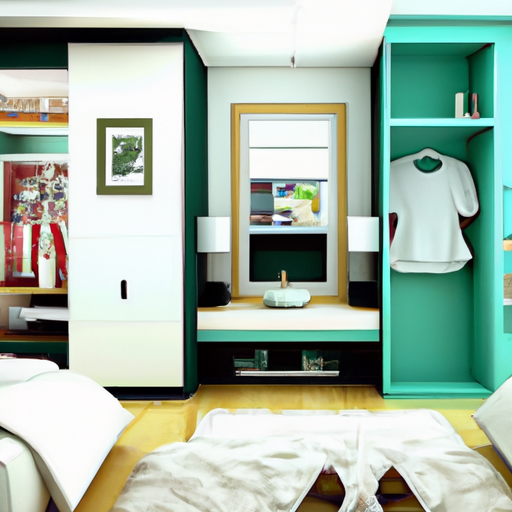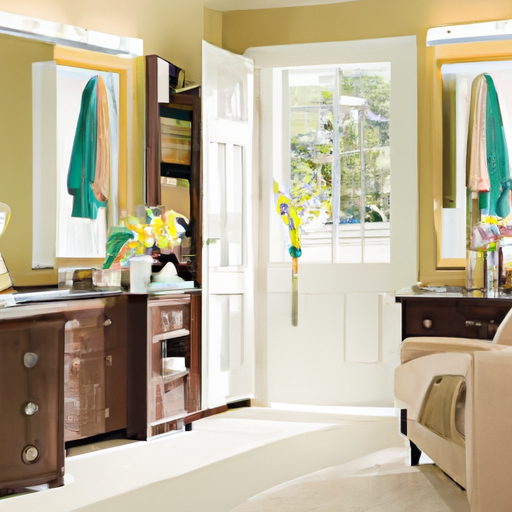
Are you tired of feeling cramped in your small space and longing for a more open and spacious atmosphere? If so, you’re not alone. Many people live in compact living quarters and wonder, “How can I make my small space look bigger?” Well, fret not, because we’ve got some tips and tricks up our sleeve to help you maximize your space and create the illusion of a larger, more open area. Whether it’s clever furniture placement, strategic lighting choices, or using optical illusions, you’ll be amazed at how a few simple design tweaks can transform your small space into a roomy, inviting haven. So, let’s dive right in and discover the secrets to making your small space feel bigger and brighter.
Color
Choose light colors
When it comes to making a small space look bigger, choosing the right colors can have a significant impact. Opting for light colors, such as whites, neutrals, and pastels, can create an illusion of space and brightness. Lighter colors reflect more light, making the room feel airy and open. On the other hand, darker shades can make a space appear smaller and more enclosed. So, stick to light colors for your walls, ceilings, and main furniture pieces to make the most of your small space.
Use a monochromatic color scheme
In addition to choosing light colors, employing a monochromatic color scheme can further enhance the illusion of space. A monochromatic scheme involves using different shades and tones of a single color throughout the room. This cohesive color palette creates a sense of continuity and avoids visual fragmentation. By keeping the color tones consistent, the space feels more harmonious and expansive.
Create contrast with accents
While a monochromatic color scheme is beneficial for a small space, adding pops of contrasting color through accents can bring life and vibrancy to the room. Use bold, bright colors sparingly on accessories, artwork, or throw pillows to create a focal point and draw the eye. This contrast creates visual interest and prevents the space from feeling monotonous. However, be cautious not to overdo it, as too many strong colors can overwhelm the small space and disrupt the illusion of openness.
Lighting
Maximize natural light
One of the simplest and most effective ways to make a small space look bigger is by maximizing the use of natural light. Open curtains or blinds during the day to allow sunlight to flood the room. Natural light creates a feeling of spaciousness and highlights the dimensions of the space. Consider choosing sheer or light curtains that can still let light through while maintaining privacy. Additionally, avoid blocking windows with furniture or decor that may obstruct the flow of light.
Install mirrors to reflect light
Mirrors are a powerful tool in creating the illusion of a larger space. Placing mirrors strategically can reflect light and give the impression of depth. A large mirror hung opposite a window can double the amount of natural light in the room, making it feel brighter and more open. Additionally, using mirrors on walls can also create the illusion of extending the space, making it appear larger than it actually is. Experiment with different sizes and placements to achieve the desired effect.
Use strategic artificial lighting
In addition to natural light, incorporating artificial lighting strategically can also contribute to making a small space look bigger. Use a combination of ceiling lights, floor lamps, and table lamps to evenly distribute light throughout the room. Avoid relying solely on a single overhead light, as it can create harsh shadows and make the space feel smaller. Aim for a balanced and well-lit environment that enhances the overall openness and brightness of the area.

Furniture
Opt for small-scale furniture
Choosing the right furniture is crucial when working with a small space. Opt for small-scale furniture that fits proportionally within the room. Bulky and oversized pieces can make the space feel cramped and crowded. Look for furniture with sleek profiles and streamlined designs to maximize the available floor area. Consider measuring your space and creating a floor plan to ensure that each piece of furniture has adequate clearance and doesn’t obstruct the flow of the room.
Choose furniture with legs
When selecting furniture for a small space, prioritize pieces with legs. Furniture that stands off the ground creates a sense of visual lightness and openness. The visible floor space beneath the furniture gives the illusion of more square footage and allows light to flow freely throughout the room. Additionally, furniture with exposed legs also makes cleaning and maintenance easier, as you can easily reach underneath and around the pieces.
Use multifunctional furniture
In a small space, optimizing functionality is key. Look for furniture pieces that serve dual purposes to make the most of your limited square footage. For example, consider a sofa bed or a coffee table with hidden storage compartments. A desk that doubles as a dining table can also be a smart choice. By incorporating multifunctional furniture, you can maximize the usability of the space while minimizing clutter.
Layout
Create an open floor plan
An open floor plan is a fantastic way to make a small space feel more spacious and connected. Consider removing unnecessary walls or barriers to create a seamless flow between different areas. By combining the living room, dining area, and kitchen into one open space, you can eliminate visual barriers and increase the sense of openness. An open floor plan allows light to travel more freely, making the entire area feel larger and more cohesive.
Maximize vertical space
When dealing with limited floor space, it’s essential to think vertically. Maximize the vertical space in your small room by utilizing high ceilings. Consider floor-to-ceiling bookshelves or tall storage cabinets to make use of every inch of available space. Hang artwork or shelving higher on the walls to draw the eye upward, creating an illusion of height. By maximizing the vertical dimension, you can make a small room feel more voluminous and open.
Arrange furniture strategically
How you arrange your furniture can greatly impact the perception of space in a small room. Avoid pushing all the furniture against the walls, as it can create a boxed-in feeling. Instead, pull furniture away from the walls and arrange it in a way that creates conversational groupings and maximizes flow. Leave enough space between pieces to allow for comfortable movement and to avoid a cluttered appearance. Experiment with different layouts until you find one that optimizes both functionality and visual openness.

Storage
Use hidden storage solutions
A cluttered space can make even the largest room feel small and cramped. Utilize hidden storage solutions to keep your small space organized and visually clean. Look for furniture pieces with built-in storage compartments, such as ottomans with hidden storage or beds with drawers underneath. Use decorative baskets and bins to corral small items and keep them out of sight. By minimizing visible clutter, you can create an atmosphere of spaciousness and tranquility.
Utilize vertical wall space
When storage space is limited, turning to the walls can provide much-needed additional storage options. Install floating shelves or wall-mounted cabinets to store books, decorative items, or everyday essentials. Hanging baskets or hooks can also be used for items like kitchen utensils or hats and scarves. Utilizing vertical wall space not only adds storage opportunities but also keeps the floor clear and uncluttered, making the room feel more open.
Invest in dual-purpose furniture
Another effective storage solution for a small space is investing in furniture that serves multiple purposes. Look for items like storage ottomans that can be used as seating and provide hidden storage. A console table with drawers can provide both a decorative surface and additional storage for items like keys or small electronics. By choosing furniture that doubles as storage, you can keep your belongings organized while minimizing the need for extra storage units.
Decorative Elements
Hang curtains high and wide
To create an illusion of height and spaciousness, hang curtains as close to the ceiling as possible. This gives the impression of taller walls and draws the eye upward, making the room feel bigger. Opt for curtains that are wider than the actual window to create the illusion of width. When the curtains are open, they won’t block the windows, allowing more natural light to enter the space. This simple trick can dramatically enhance the perceived size of your small room.
Add large mirrors
Mirrors not only reflect light but also create a sense of depth and expansiveness. Consider adding a large mirror to one of the walls in your small space. When placed strategically, a mirror can visually double the size of the room by creating the illusion of another dimension. Choose a mirror with an interesting frame or shape to add a decorative element while maximizing its impact on the perceived space.
Use wall art to create depth
Strategically placed wall art can create a sense of depth and make a small space look bigger. Opt for artwork that features perspective or has varying levels of detail to add visual interest. Hang artwork at different heights to draw the eye upward and create a feeling of verticality. Avoid overcrowding the walls with too many pieces, as this can make the space feel cluttered. Instead, choose a few impactful pieces that complement the overall design and add depth to the room.

Flooring
Opt for light-colored flooring
Just like light-colored walls, light-colored flooring can visually expand a small space. White or light-colored flooring creates a seamless and continuous look that extends the perceived boundaries of the room. However, keep in mind that light-colored floors may require more maintenance, as they can show dirt and stains more easily. Choose flooring materials like light-colored hardwood, laminate, or tile to achieve a fresh and open atmosphere in your small space.
Use larger tiles or planks
When selecting flooring for a small room, opting for larger tiles or planks can create a sense of spaciousness. Larger tiles or planks reduce the number of visible seams and lines, giving the illusion of a larger expanse. This seamless look minimizes visual fragmentation and makes the flooring appear more expansive. Additionally, larger tiles or planks can create a more contemporary and streamlined aesthetic that complements modern small spaces.
Create visual continuity with flooring
To make a small space feel cohesive and connected, consider using similar flooring throughout different areas. When transitioning between rooms, maintaining consistency in flooring material and color creates a seamless flow and eliminates visual interruptions. This sense of continuity removes the perception of separate small compartments, making the space feel more open and unified. By visually connecting the various areas, you can maximize the perceived size of your entire living space.
Window Treatments
Choose sheer or light curtains
When it comes to window treatments in a small space, opting for sheer or light curtains can be advantageous. Sheer curtains allow for maximum light penetration while still providing a level of privacy. The translucent fabric creates a soft, diffused glow that brightens the room and gives the illusion of a larger and more open space. Light-colored curtains also contribute to the overall brightness and airiness of the room, enhancing the desired visual effect.
Avoid heavy drapes
In contrast to sheer curtains, heavy drapes can overpower a small space and make it feel more enclosed. Avoid thick or dark-colored drapes that absorb light and block the view. Heavy materials can add visual weight to the windows, which can make the room appear smaller. Keep your window treatments light and airy to maximize the amount of natural light and maintain an open and spacious atmosphere.
Use blinds or shades
Another alternative to curtains is using blinds or shades, especially in spaces where privacy is a priority. Blinds and shades can be adjusted to control the level of light and view, providing flexibility in a small space. Choose blinds or shades with slim profiles to minimize visual obstructions and keep the focus on the windows. By utilizing these window treatments, you can easily adjust the ambiance of the space while maintaining the illusion of a larger area.

Decluttering
Minimize furniture and accessories
A cluttered space can instantly make even the most extensive room feel small and suffocating. Minimizing the amount of furniture and accessories in your small space is essential to maintaining an open and airy atmosphere. Consider decluttering and donating items that are no longer needed or don’t serve a specific purpose. Keep only the essentials and choose furniture and decor pieces that truly contribute to the functionality and aesthetic of the room. By reducing visual clutter, you can create a sense of spaciousness and tranquility in your small space.
Organize belongings
Organization is key to maintaining an uncluttered and visually open small space. Find appropriate storage solutions for your belongings and categorize them accordingly. Whether it’s using labeled bins, drawer dividers, or shelves, having a designated spot for each item helps keep everything in its place and prevents visual chaos. When everything is neatly organized and easily accessible, your small space will feel more streamlined and spacious.
Utilize storage solutions
In addition to decluttering and organizing, utilizing storage solutions designed specifically for small spaces can make a significant difference in the perceived size of your room. Look for innovative storage solutions, such as under-bed storage containers, stackable and nesting containers, or hanging organizers. Utilizing vertical wall space and finding compact furniture with built-in storage compartments can also help maximize your storage capabilities. By making the most of every available space, you can keep clutter at bay and maintain a visually open small space.
Illusion Techniques
Hang curtains from ceiling to floor
To create the illusion of taller walls, hang curtains from ceiling to floor. This elongates the visual height of your small space, making it feel grander and more expansive. When curtains don’t stop at the window sill, the eye is drawn upward, emphasizing the vertical dimension. Pair this technique with sheer or light curtains to allow maximum light flow and maintain the desired ethereal atmosphere. By utilizing this illusion technique, you can instantly transform your small room into a more grand and open environment.
Create visual balance with furniture
Achieving visual balance in a small space is crucial to maintain an open and uncluttered atmosphere. Place your furniture strategically to create a sense of equilibrium and harmony. For example, if you have a larger piece of furniture on one side of the room, balance it with another piece of similar scale or weight on the opposite side. This balance keeps the space from feeling lopsided and prevents visual distractions. By consciously considering and arranging your furniture to create a balanced composition, you can optimize the feeling of spaciousness in your small space.
Use optical illusions
Optical illusions can be cleverly employed to create the perception of a larger space. For instance, using stripes on walls or floors can create a sense of elongation and width. Horizontal stripes can make a narrow room feel wider, while vertical stripes can give the illusion of height. Similarly, using a large rug with diagonal patterns can add depth and dimension to a small area. These visual tricks manipulate the perception of the room’s size and create a more expansive and comfortable environment. Experiment with different optical illusions to find the ones that best suit your small space.
In conclusion, making a small space look bigger requires careful consideration of color choices, lighting techniques, furniture selection, layout, storage solutions, decorative elements, flooring, window treatments, decluttering, and illusion techniques. By following the tips and strategies outlined above, you can transform your small space into a visually open and inviting environment. Remember, simplicity, organization, and strategic design choices are key to maximizing the perceived size and livability of your small space. With a bit of creativity and thoughtfulness, you can create a home that feels spacious, comfortable, and uniquely yours, regardless of its size.

